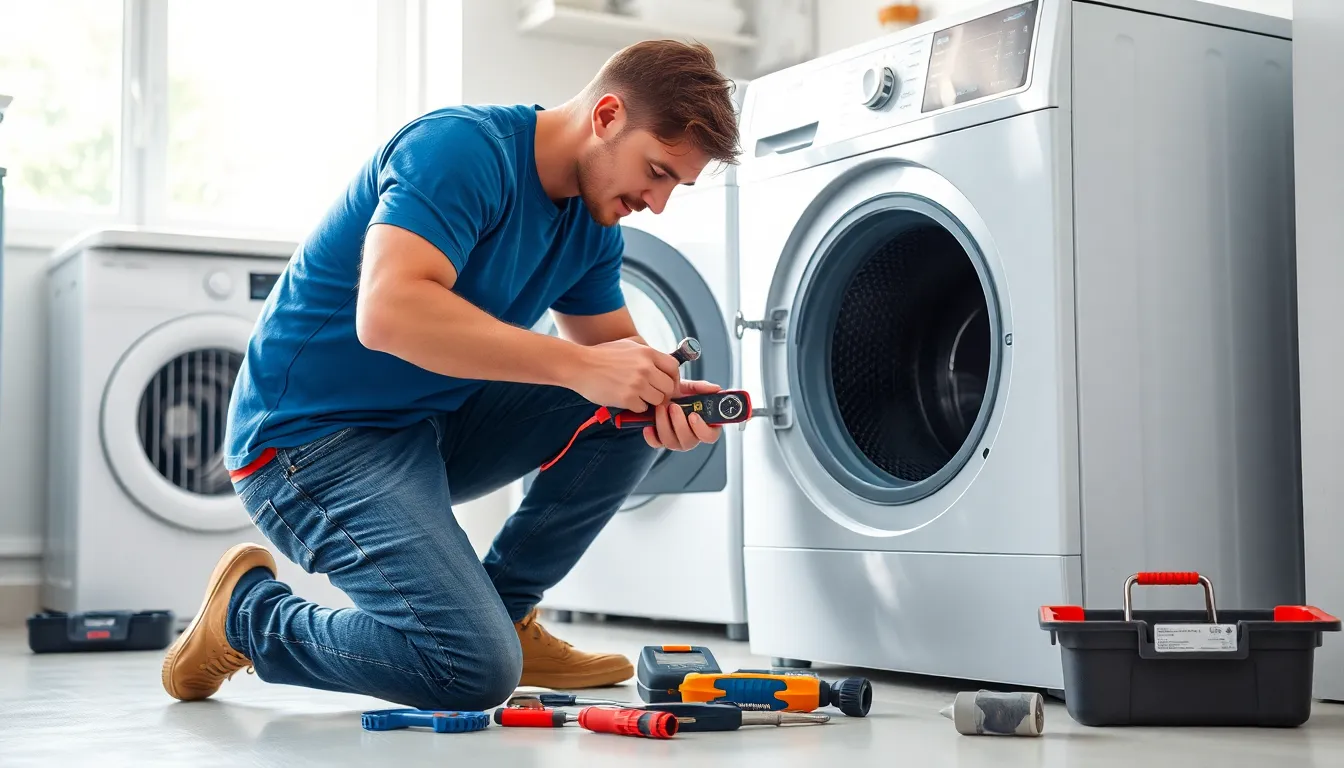When your washing machine decides to take an unexpected vacation, it can feel like life’s come to a screeching halt. Suddenly, the pile of laundry looks more like a mountain range, and the thought of hand-washing clothes feels like a punishment straight out of medieval times. But fear not! Washing machine repair isn’t as daunting as it seems.
With a little knowledge and the right tools, anyone can tackle minor issues and save themselves a hefty repair bill. Whether it’s a stubborn spin cycle or a mysterious leak, understanding the common problems can turn a laundry disaster into a quick fix. So grab your toolbox and let’s dive into the world of washing machine repair—because who wants to resort to a laundromat when you can become the hero of your own home?
Table of Contents
ToggleCommon Washing Machine Issues
Washing machines often face issues that can disrupt laundry routines. Understanding these common problems helps in addressing them efficiently.
No Power or Start
No power typically signals an electrical issue. Inspect the power cord for damage and ensure it’s firmly plugged in. A tripped circuit breaker may also cause this problem. Check the fuse box, and reset any breakers as needed. If these steps don’t resolve the issue, the problem could lie within the machine’s control board or door latch. Testing or replacing these components might be necessary if all else fails.
Leaking Water
Leaking water usually indicates a problem with hoses or seals. Examine the water supply hoses for cracks or loose connections. Tighten any loose fittings, and consider replacing faulty hoses. A worn door seal can also lead to leaks, causing water to escape during the wash cycle. Inspect the door gasket for any signs of damage, and replace it if necessary to prevent further issues.
Unresponsive Controls
Unresponsive controls can stem from multiple factors. Sometimes, control panel buttons can stick, making it seem unresponsive. Cleaning the panel may resolve this issue. Other times, a malfunctioning control board may be to blame. Resetting the washing machine by unplugging it for a few minutes could also help. If issues persist, checking the connections and wiring to the control board typically aids in diagnosing the problem.
Tools Needed for Washing Machine Repair

Repairing a washing machine requires specific tools and safety equipment. Having the right items on hand makes the process smoother and more efficient.
Essential Tools
Wrenches are important for loosening and tightening nuts and bolts. Screwdrivers, both flathead and Phillips, assist in removing screws from various machine parts. Pliers help with gripping and manipulating wires and hoses. A multimeter measures electrical current to diagnose power issues. Replacement parts, such as hoses and seals, may become necessary during repairs. Each tool contributes to effectively addressing common washing machine problems.
Safety Equipment
Goggles protect the eyes from dust and debris during repairs. Gloves offer hand protection while handling sharp objects and potentially hazardous materials. A dust mask helps prevent inhalation of particles, especially when working on older machines. Proper footwear, like closed-toe shoes, enhances safety by providing foot protection. Each piece of safety equipment ensures a secure and cautious approach to washing machine repair tasks.
Step-By-Step Repair Guide
Washing machine repair involves diagnostic and repair steps. Following this guide helps tackle common issues effectively.
Diagnosing the Problem
Identifying the specific problem is crucial. Start by checking the power supply, ensuring the cord is secure and the outlet is functional. Monitor unusual sounds during operation; they often indicate underlying mechanical issues. Observe leaks by checking hoses and seals for damage. Test the control panel responsiveness; unresponsive controls usually require inspection of the wiring. This systematic approach pinpoints the exact issue, streamlining the repair process.
Fixing Electrical Issues
Addressing electrical issues demands precision. Check the circuit breaker first; a tripped breaker might cut power to the washing machine. Replace any damaged parts like the door latch or control board without delay. Utilize a multimeter to diagnose complex electrical faults, like faulty wiring. Always disconnect the appliance from the power source before performing any repairs to ensure safety. Reassemble components carefully to avoid future malfunctions, ensuring connections are tight and secure.
Addressing Mechanical Problems
Mechanical problems can disrupt the washing cycle. Inspect the belt for wear and tear; a frayed belt might not spin the drum effectively. Lubricate moving parts to reduce friction and extend their lifespan. Evaluate the water pump for clogs or damage, facilitating efficient water drainage. If necessary, tighten loose screws to stabilize components during operation. Each repair step influences the washing machine’s performance, promoting functionality and longevity.
When to Call a Professional
Recognizing when to call a professional for washing machine repair can save time, effort, and money. Some issues demand expert attention.
Signs You Need Help
Common signs signal the need for professional help. Unusual noises during operation can indicate mechanical issues. Persistent leaks, despite replacing hoses or seals, often require expert investigation. If the machine displays error codes, it might stem from complex electrical faults. In situations where the washer fails to drain or spin properly, calling a technician is wise, as this could indicate a malfunctioning pump. Lastly, if previous DIY fixes haven’t resolved the problem, turning to a professional can provide a lasting solution.
Cost-Benefit Analysis
Evaluating the cost-effectiveness of repairs requires careful consideration. Repairing minor issues often costs less than purchasing a new machine, especially when repairs range from $100 to $300. Significant problems, however, may incur higher repair bills, sometimes surpassing half the cost of a new model. Weighing repair costs against replacement expenses helps determine the best course of action. If the washing machine is over a decade old, investing in a new model could yield better energy efficiency and warranty coverage. In short, assessing both immediate costs and long-term benefits leads to more informed decisions.
Conclusion
Washing machine repair doesn’t have to be a daunting task. With the right knowledge and tools, anyone can tackle common issues and restore their appliance to working order. Understanding the typical problems and having essential tools ready can save both time and money.
For those who prefer a hands-on approach, following the outlined steps can lead to successful repairs. However, recognizing when to seek professional help is equally important. By weighing the costs of repair against the benefits of replacement, individuals can make informed decisions that best suit their needs. Ultimately, maintaining a washing machine not only enhances its longevity but also ensures a smoother laundry experience.



